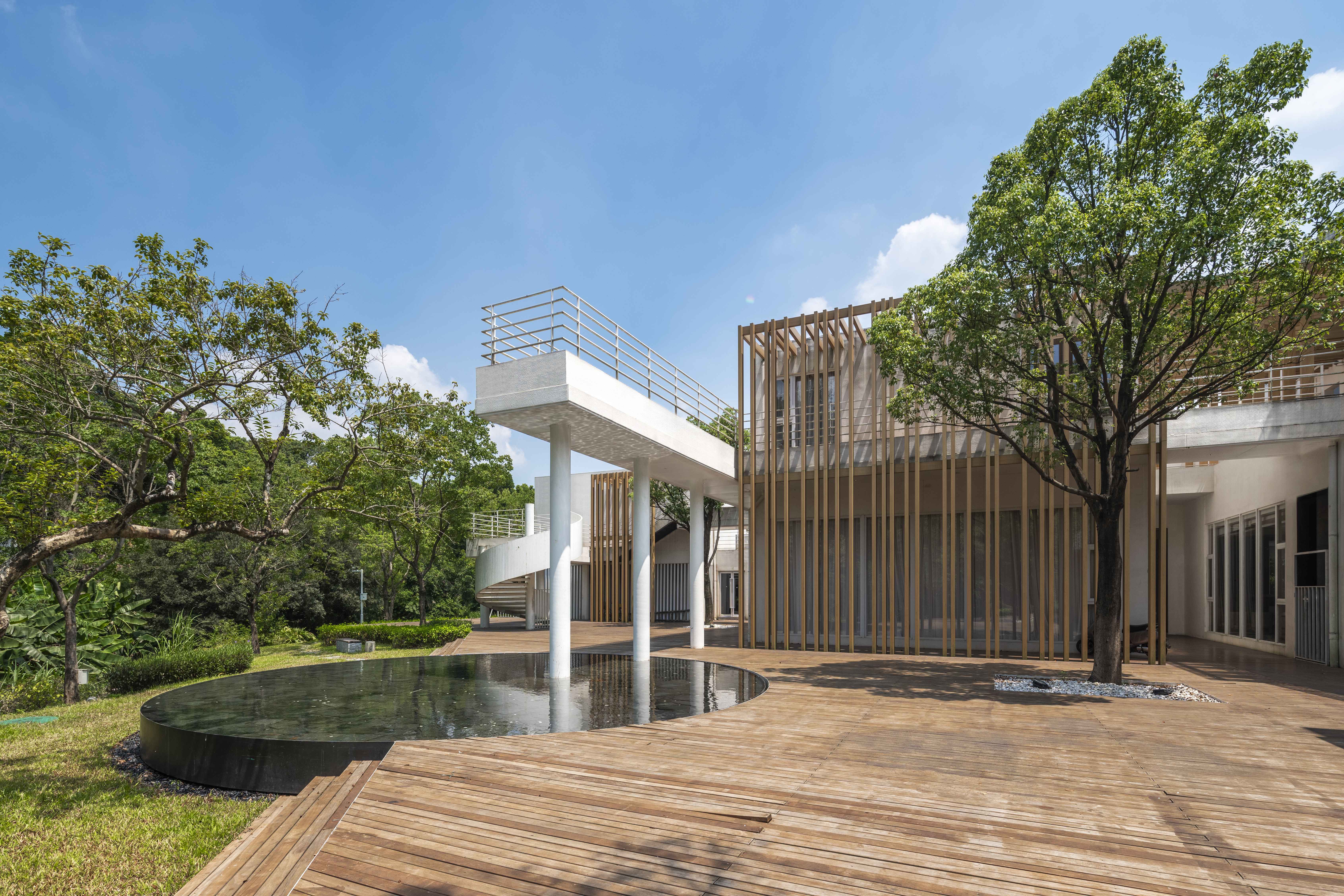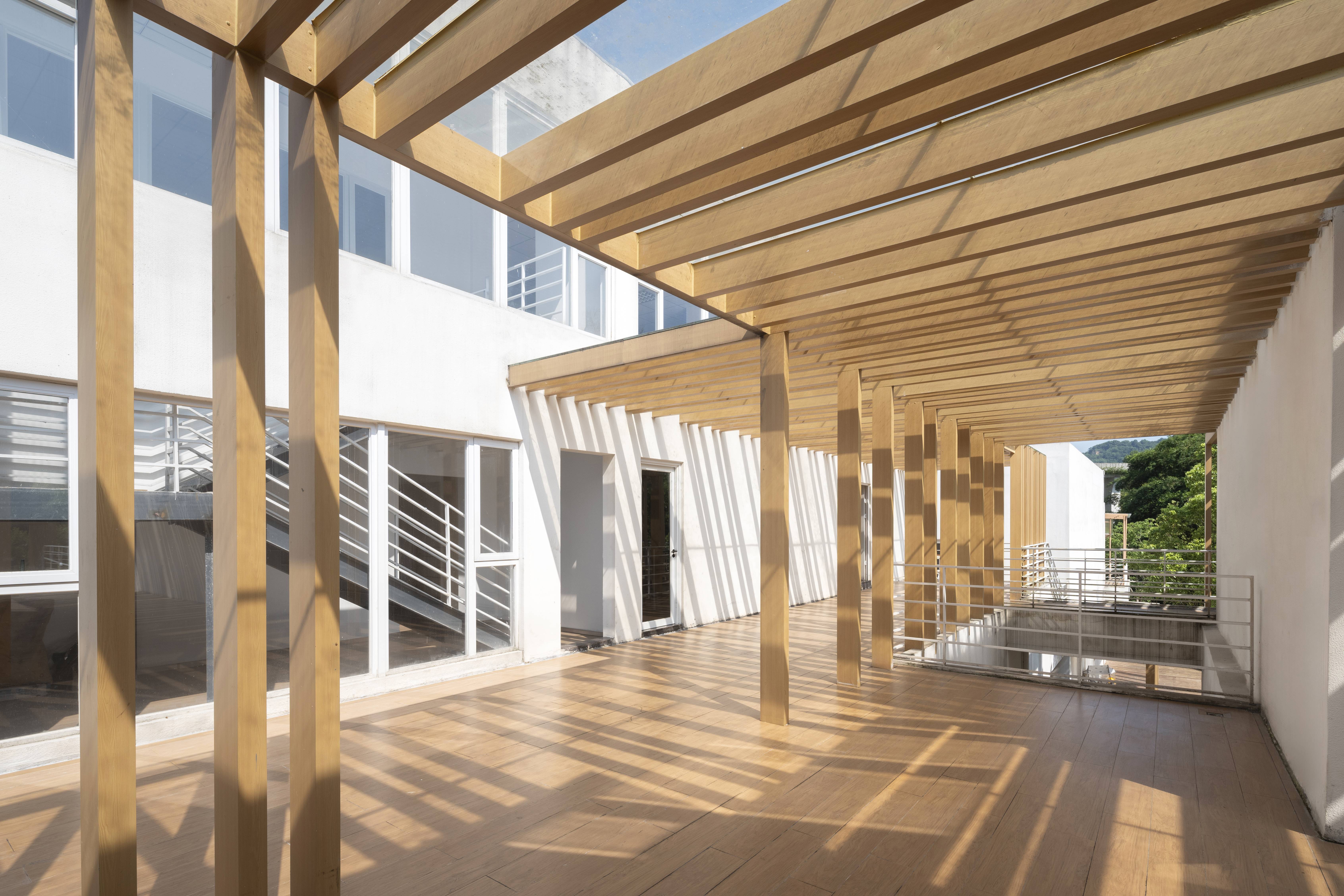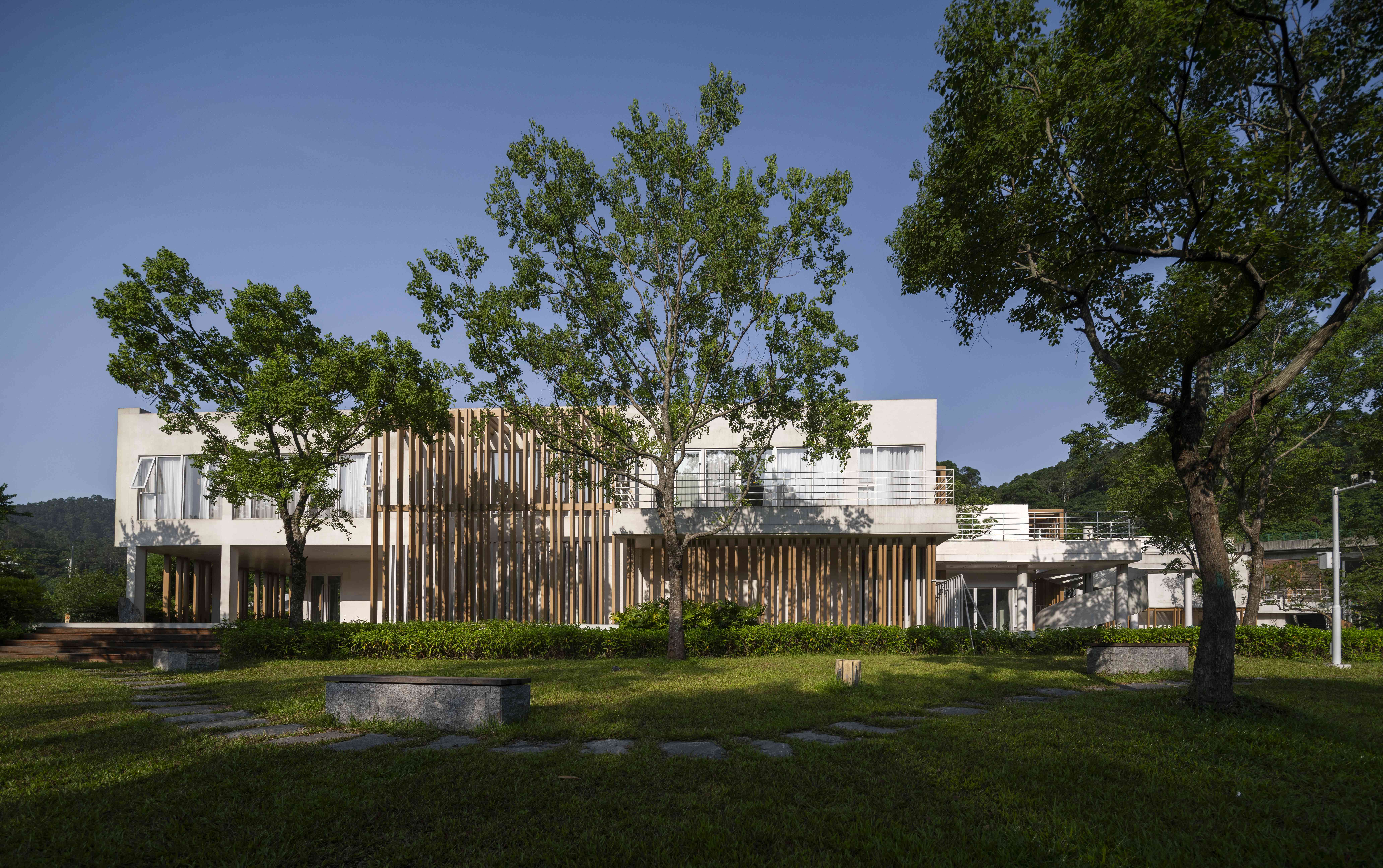


建筑及室内设计 三文建筑
项目地点 广东广州
建成时间 2022年10月
用地面积 8000平方米
场地和项目概况
Site and Project Overview
项目场地位于广州市黄埔区长岭街道黄麻村村口,黄麻路与广汕公路交汇处,是人们进入黄麻村的必经之路。场地北高南低(有大约1米的高差);南侧为城市主要道路,西侧是进村的道路和高架桥,东侧为林地和临时停车场。溪流龟咀涌从场地中穿过,将场地分为东西两块用地。
The project site is located at the entrance of Huangma Village, Changling Sub-district, Huangpu District, Guangzhou, at the intersection of Huangma street and Guangshan Road which is a necessary path for people to enter Huangma Village. The site high in the north and low in the south (with a height difference of approximately 1 meter). The south side is the main road, the west side is the road leading to the village and the viaduct, and the east side is the forest land and temporary parking lot. The Guizuichong Creek passes through the site and divides it into two parts: east and west.
项目是黄麻村乡村振兴和旧改项目的重要组成部分,主要功能包括:展厅、配套办公、接待服务,及新的村委会等。根据使用需要,项目被分为两部分:首先完成的是位于溪流(龟咀涌)东面的乡村会客厅(完成于2021年10月);稍后完成的是位于场地北部的乡村振兴工作站(完成于2022年10月)。除建筑外,周边的环境也需要设计和提升,在服务本村和周边居民休闲娱乐的同时,也成为黄埔区城市景观的一部分。
The project is an important component of the Huangma Village rural revitalization and old renovation project, with main functions including exhibition hall, supporting office, reception services, and the new village committee. According to usage needs, the project is divided into two parts: the first one is the rural reception hall located to the east of the creek, completed in October 2021; The rural revitalization workstation is located in the northern part of the site, which was completed later in October, 2022). In addition to buildings, the surrounding environment also needed to be designed and improved, serving the leisure and entertainment of the village and surrounding residents, while also becoming a part of the urban landscape of Huangpu District.

▲ 项目视频 ©三文建筑
设计概念和总体布局
Design Concept and Overall Layout
在和业主沟通后,建筑师和业主方达成了共识:乡村振兴工作站应该朴素实用,并不追求奢华,但也要有品质感。建筑要尽可能轻盈,并对环境轻扰动;应采用装配式的方式建造,从而缩短工期。此外,如果可能,建筑还应该是可拆除的,场地可以重新还原为土地。
After communicating with the owner, the architect and the owner reached a consensus: the rural revitalization workstation should be simple and practical, not pursuing luxury, but also having a sense of quality. Buildings should be as lightweight as possible and have minimal disturbance to the environment. It should also be constructed in a prefabricated manner to shorten the construction period. In addition, if possible, the building should also be removable and the site can be restored to land.
乡村振兴工作站被布置在场地北端,地势较高的区域,它包括:展厅、嘉宾接待及新的村委会。因为场地西侧有高架桥,这是广汕公路链接广佛肇高速的城市快速路,繁忙的交通会对工作站产生影响,建筑在西侧退线10米。同时,为了尽量不破坏建筑西侧的溪流和林地,工作站主体建筑在东侧沿溪流走势布局,并尽量后退,保持了溪流的距离。与工作站隔溪流相望是乡村会客厅,它是一个小巧的环形建筑,主要功能是茶室。
The rural revitalization workstation is located at the northern end of the site, in a relatively high terrain area, incl. an exhibition hall, guest reception, and a new village committee. Due to the presence of an elevated bridge on the west side, which is an urban expressway connecting the Guangzhou-Foshan-Zhaoqing Expressway with the Guangzhou-Shantou Highway, the busy traffic will have an impact on the workstation, so the building is backed off by 10 meters on the west side. At the same time, in order to minimize the damage to the stream and forest on the west side of the building, the main body of the workstation is arranged along the stream trend on the east side, and the distance to the stream is maintained as much as possible. Across the stream from the workstation is the rural reception hall, which is a small circular building with the main function of a tea room.


乡村振兴工作站
Rural Revitalization Workstation
工作站采用类集装箱的模式建造,由预制化的钢框架为支持构建,配以装配式的外立面和地板。建筑分为展厅、嘉宾接待、村委会三个区域,各区域具有独立的出入口,可分可合。根据功能需要,建筑各部分高度不同,其中展厅高度为9米,其他部分的层高为3.6米。因为建筑由模块组成,可以很好适应地形。建筑南侧和西侧边界平整,东侧则与自然环境相互渗透,形成共生关系。
The workstation is constructed in a container like manner, supported by prefabricated steel frames and equipped with prefabricated facades and floors. The building is divided into three areas: exhibition hall, guest reception, and village committee, each with independent entrances and exits that can be divided or combined. According to functional requirements, the height of each part of the building varies, with the exhibition hall being 9 meters high and the other parts having a floor height of 3.6 meters. Because the building is composed of modules, it can adapt well to the terrain. The boundary between the south and west sides of the building is flat, while the east side permeates with the natural environment, forming a symbiotic relationship.



展厅和嘉宾接待的入口面向南边的绿地,展厅入口前的浅水池形成进入建筑的前导景观,增强了仪式感。水池与微地形和高大乔木一起,使建筑与南侧的景观连为一体,让工作站成为小公园的一部分。村委会位于建筑北区,入口面向西侧的黄麻路,方便本村人抵达。展厅、嘉宾接待区域与村委会之间有通道分割,并在嘉宾接待区的北侧设有一个小庭院,将外来人员和村民的流线分开。庭院东侧与溪流、林地毗邻,院中有水池、树木,并通过螺旋楼梯与二楼的廊道连接,形成怡人且丰富的小景观。
The entrance of the exhibition hall and guest reception faces the green space to the south, and the shallow water pool in front of the entrance forms a leading landscape into the building, enhancing the sense of ceremony. The pool, along with the micro terrain and tall trees, connects the building with the southern landscape, making the workstation a part of the small park. The village committee is located in the north area of the building, with the entrance facing Huangma Road on the west side, which is convenient for the local villagers to arrive. There are channel divisions between the exhibition hall, guest reception area, and village committee, and a small courtyard is set up on the north side of the guest reception area to separate the flow lines of outsiders and local villagers. The east side of the courtyard is adjacent to the stream and forest. There are pools and trees in the courtyard, connected to the corridor on the second floor through spiral stairs, forming a pleasant and interesting small landscape.




首层大量使用了甬道,既将三个不同的功能区域分割开,又应对了广州地区炎热多雨的气候,形成自然通风的路径。建筑首层基础和部分区域的架空处理进一步加强了对气候的回应。此外,建筑首层地面尽量不硬化,采用点基础和架空防腐木地板。建筑地面整体抬升,雨水可以很好地渗透入地面,形成水的循环。
The first floor extensively uses corridors, which not only divide three different functional areas but also cope with the hot and rainy climate in Guangzhou, forming a natural ventilation path. The overhead treatment of the first floor foundation and some areas of the building further strengthens the response to the local climate. In addition, the ground of the first floor of the building is not hardened as possible, while point foundations and elevated anti-corrosion wooden floors are used. The overall elevation of the building floor allows rainwater to penetrate well into the ground, forming a cycle of water.



建筑的三个区域在二层被廊道连接在一起。廊道分为窄长的栈道和较为宽大的平台,在连接各区域同时,也增加了半户外活动的空间。廊道和首层的甬道并不完全重合,错位的处理使建筑体块之间的灰空间在水平和垂直渗透方面更为丰富。设计之初,建筑部分屋顶还设计了屋顶绿化,立面也采用垂直绿化,但由于后期对于成本的控制,很遗憾没有实现。
The three areas of the building are connected by the corridor on the second floor. The corridor is divided into a narrow and long walkway and a relatively wide platform, which not only connect various areas but also increase the space for semi outdoor activities. The corridor and the first floor corridor do not completely overlap, and the treatment of misalignment makes the gray space between the building blocks more abundant in terms of horizontal and vertical infiltration. At the beginning of the design, the roof of the building was also designed with roof greening, and the facade with vertical greening. However, unfortunately, due to cost control in the later stage, it was not achieved.



建筑外立面采用简洁朴素的处理,以白色真石漆搭配木格栅为主。木格栅为建筑包裹了第二层表皮,一方面起到了一定的遮阳作用,另一方面丰富了建筑立面的虚实关系。简约的外立面设计,给人清爽的感觉,很好的平衡了建筑的“临时性”与艺术性。
The exterior facade of the building adopts a simple and plain treatment, mainly consisting of white real stone paint paired with wooden grilles. The wooden grilles wrap the second layer of the building's surface, providing a certain shading effect and enriching the virtual and real relationship of the building's facade. The minimalist exterior design gives a refreshing feeling, effectively balancing the "temporary" and artistic aspects of the building.




乡村会客厅
Rural Reception Hall
乡村会客厅位于龟咀涌的东侧,主要功能是茶室。它面积很小,宽大的屋顶和透明的外立面使其很好的与环境景观相融合,成为一个新式的亭。
The rural reception hall is located on the east side of the stream and mainly serves as a tea room. It has a small area, and its spacious roof and transparent facade blend well with the environmental landscape, becoming a modern pavilion.


建筑成环形,建筑中央有一个圆形的内庭,屋顶外侧高、内侧低,形成了四水归堂之势。建筑的外立面朝向工作站和公园的部分为落地玻璃。通透的界面将室外的景观拉入室内空间,也让工作站和会客厅之间形成了视线上的交流。部分落地玻璃内侧使用木格栅,遮阳的同时,也呼应了乡村振兴工作站的外立面形式。
The building is circular in shape, with a circular inner courtyard in the center. The roof is high on the outer side and low on the inner side, forming the traditional “Four waters returning to the central courtyard” trend. The exterior façade of the building facing the workstation and park adopts floor to ceiling glass windows. The transparent interface pulls the outdoor landscape into the indoor space, and also creates a visual exchange between the workstation and the reception hall. Part of the floor glass windows uses wooden grating on the inner side, which not only provides shade but also echoes the exterior form of the rural revitalization workstation.



为了让建筑更为轻透,会客厅的结构采用钢结构。在设计中建筑师和结构工程师讨论,希望尽可能少的设立柱子。最终,钢柱分为内外两圈,外圈位于外立面内侧,8根;内圈柱子环绕内院布置,比外圈柱子减少一半,为4根。
In order to make the building lighter and more transparent, the reception hall adopts steel structure. In the design, architects and structural engineers discussed and hoped to set up as few columns as possible. Finally, the steel columns are divided into inner and outer rings, with the outer ring of 8 columns located on the inner side of the exterior façade, and the inner circle of columns are arranged around the inner courtyard, reducing by half the number of outer circle columns to 4.



建筑入口部分采用内凹的处理,内凹的部分在地面设立浅水池和汀步石,客人需要“踏水而行”进入建筑。此处的立面使用了封闭墙面的处理,并配以中式的六角窗和假山。整个处理让人想到中式园林建筑,这给会客厅以文化感和趣味性。
The entrance of the building adopts an inward concave treatment, and the inward concave part is equipped with a shallow water pool and stepping stones on the ground. Guests need to "step on the water" to enter the building. The facade here uses a closed wall treatment, accompanied by Chinese style hexagonal windows and rockery. The entire process reminds people of Chinese garden architecture, which gives the reception hall a sense of culture and fun.

会客厅的室内设计也力求清爽,地面采用平整的水磨石,分割线按照扇形布置,回应了建筑的形态。屋顶呈碗底状,采用木饰面,灯光和空调口被巧妙地和木饰面的缝隙融合,保证了空间的完整性。室内屋顶的弧度向室外延伸,成为建筑出挑的檐。与出檐对应的是建筑外围高于地面的环形台,它既可以为客人提供室外休息的座位,又让建筑从地面“漂浮”起来,增加了建筑的轻盈感。
The interior design of the reception hall also strives for freshness, with flat terrazzo floors and fan-shaped dividing lines, reflecting the architectural form. The roof is bowl shaped and features a wooden veneer. The lighting and air conditioning outlets are cleverly integrated with the gaps in the wooden veneer, ensuring the integrity of the space. The curvature of the indoor roof extends outward, becoming the overhanging eaves of the building. Corresponding to the eaves, there is a circular platform above the ground on the periphery of the building, which provides outdoor seating for guests to rest and also allows the building to "float" from the ground, increasing the lightness of the building.


结语
Conclusion
“轻”是本项目最为突出的设计理念。从建筑与环境的关系,到工作站建造形式的选择,乡村会客厅的形态和质感,再到两组建筑在结构和细节上的处理,建筑师希望建筑以不同层面的“轻”来表达自己。这些“轻”不仅包括形态和构造上的轻盈、轻巧,也包含建筑对土地、环境轻干扰和轻改变的关系和态度。
'Light' is the most prominent design concept of this project, from the relationship between architecture and environment, to the choice of workstation construction form, the form and texture of rural reception hall, and further to the handling of the structure and details of the two groups of buildings. The architects hope that architecture expresses itself with different levels of 'lightness', which not only include lightness in form and structure, but also include the relationship and attitude of the building towards light interference and change in land and environment.





设计单位 ▽



完整项目信息
名称:黄麻乡村振兴工作站与乡村会客厅
地点:广东省广州市黄埔区长岭街道黄麻村
业主:敏捷集团
建筑及室内设计:三文建筑
主创建筑师:何崴、陈龙
团队成员:唐静、王梓亦、孟祥婷、周俊杰、王东升、刘泳、朱艳明
设计时间:2021年3月—2021年7月
建成时间:2022年10月
用地面积:8000平方米
建筑面积:乡村振兴工作站5200平方米,乡村会客厅210平方米
摄影:金伟琦
版权声明:本文由三文建筑授权发布。欢迎转发,禁止以有方编辑版本转载。
投稿邮箱:media@archiposition.com
上一篇:经典再读198 | 塞伊奈约基:阿尔托的城市
下一篇:生长与共享:深圳光明科学城启动区项目 / 同济院-设计一院